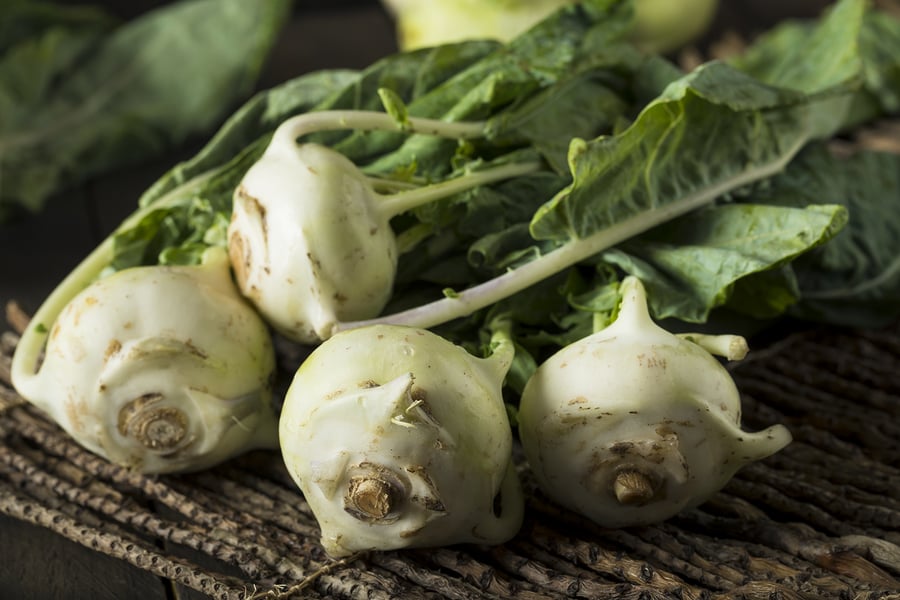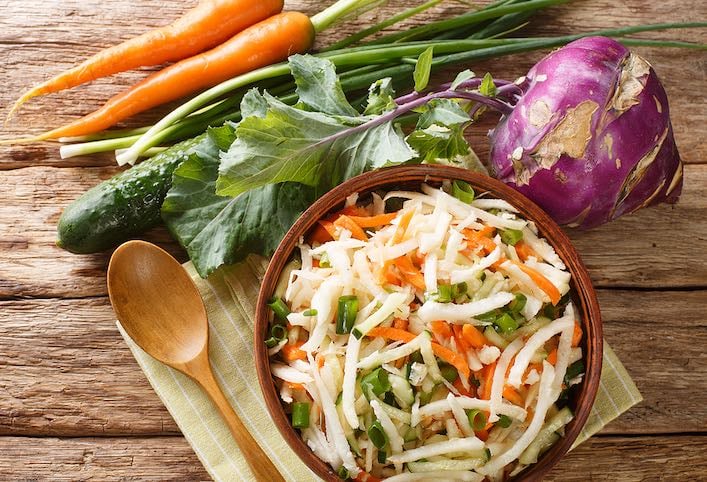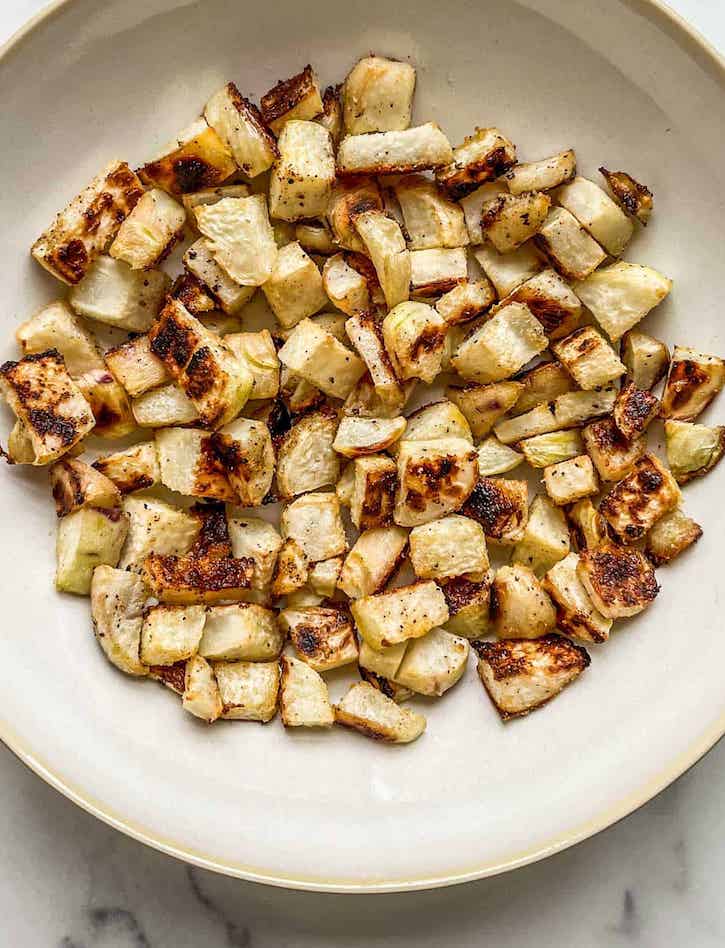With its protruding stems, kohlrabi has an image issue to get past, looking more alien than edible at a glance. This concise guide offers ideas on how to use kohlrabi, tips on buying and storing, links to recipes, and more. It’s a tasty and versatile vegetable that deserves more attention!

Despite its offbeat exterior, on the inside it reveals a gentle, mild flavor that hints at its versatility, given a chance to get out of the root cellar and into the kitchen.
What is Kohlrabi and Where Did it Come From?
Decidedly German in origin, the name itself is derived from a combination of the words for cabbage (“kohl”) and turnip (“rübe” or “rabi”). Other names for this vegetable include “kohl-rabi,” “German turnip,” “stem turnip” and “cabbage turnip.”
Despite that distinctive heritage, there’s little evidence of kohlrabi in history dating beyond 500 years or so. After proliferating in Northern Europe, it reached the United States around the 1800s.
Though sometimes considered a root vegetable, the bulbous growth we enjoy the most actually grows above ground. Botanically speaking, kohlrabi part of the brassica family and most closely related to wild marrow cabbage.
It’s the stem that grows to 2 to 4 inches in diameter before harvest, flanked by spindly branches supporting feathery leaves. The bulb can be either pale green or bright purple, both with a knobby, thick skin.

How to Buy and Store Kohlrabi
When shopping for kohlrabi, look for bulbs that are firm and free from blemishes. Look for smaller bulbd, which are typically more tender and less fibrous.
The leaves will most likely have already been removed if sold in a mainstream grocery store but should remain intact and fresh, vibrant, and without signs of wilting if found at a farmers market.
To store kohlrabi: Remove the leaves (which are also edible) and store the bulbs in the crisper drawer of your refrigerator. It will keep well for several weeks, though it will become increasingly tough and woody the longer it sits. Remember that it’s not root vegetables and shouldn’t be kept at room temperature for extended periods.
Wrap the leaves separately in lightly moistened paper towels before storing them in the fridge for 2 –to3 days, max. The greens are much more perishable, and unless eaten right away, should be destined for stews or sautés, rather than used raw in salads.

How to Prep Kohlrabi to use Cooked and Raw
The only barrier to enjoying kohlrabi is getting through its outer armor. Start by trimming off the stalks, if still attached using a knife or kitchen shears. Trim the stalks away from the leaves, and save the leave to use raw or cooked.
Next, trim away the stem end with a sharp knife, then use that edge to help dig your paring knife in and remove the skin all the way around, almost like peeling an apple with very thick skin.
Depending on the size of the vegetable, it may be easier to cut the bulb into quarters first and peel the individual pieces one at a time.
Now, your peeled kohlrabi is nothing if not versatile, offering both its bulb and leaves for culinary exploration. The bulb can be used similarly to potatoes, in stews, soups, mashes, and purees. It can be steamed, grilled, sautéed, roasted, or simply used raw.
In fact, you don’t need heat to enjoy a fresh, young kohlrabi. It’s wonderful enjoyed raw, thanks to its refreshing, juicy, and crisp texture. The same goes for the greens, which are also great additions to salads, or added to stir-fries, soups, and stews, especially if they’re already looking a bit limp.

Kohlrabi Nutrition Notes
Kohlrabi isn’t exactly a nutrient-dense powerhouse vegetable, but it still brings a lot to the table. Most notably low in calories and high in fiber, it’s an excellent choice for making more satisfying, voluminous meals.
Beyond that, it does have one clear antioxidant superstar that’s worth mentioning. Just one cup of raw kohlrabi contains 93% of your RDA of Vitamin C, which is even more than the average navel orange!

Kohlrabi Salad with Carrots & Cucumbers
Kohlrabi Serving Suggestions and Recipes
Once you start adding kohlwith it, you’ll discover for yourself what a winning vegetable it is, ideal for incorporating into almost any meal or snack. Here are just a few simple ideas to kickstart your inspiration.
Crudités: Thinly slice your kohlrabi into batons, wedges, or rounds and pair it with your favorite dairy-free dip to get any party started on the right foot. It’s a light, healthy, and effortless appetizer that everyone can appreciate.
Skillet or oven kohlrabi chips: Slice the peeled bulb as thinly as possible before seasoning with salt and your favorite herbs and spices, then shallow fry in olive oil. Or, toss with a little olive oil and bake at 250º F. until crispy. If you need a bit more direction, here’s Martha Stewart’s take on oven-baked Kohlrabi Chips.

Chef Bryant Terry’s Apple and Kohlrabi Slaw
Salads and slaws: Shred or slice the bulb into matchsticks as a crisp component of your favorite picnic slaw or save the fresh greens to make a lovely leafy salad. It add a great textural element to grain salads, too.
Crunchy Kohlrabi Quinoa Salad is irresistible. It’s a great addition to slaw-type salads, as shown above. Masala Herb’s Simple Kohlrabi Salad with Vinaigrette demonstrates how good it is grated.
Stir-fries: Serve both the bulb and leaves with Asian flair by making a blazingly fast stir-fry. Add tofu or tempeh for protein, and noodles or rice to turn it into a complete one-pan meal.

Kohlrabi Soup with Kohlrabi Greens (from Homemade in the Kitchen)
Soups and stews: Go ahead and toss cubes of kohlrabi into any soup like you would a starchy vegetable or cabbage to stretch it into more satisfying, voluminous servings, too. Use the greens, too, if they’ve come attached and still look nice and fresh. The soup pictured above also includes sweet potato and c
Get cozy with a comforting kohlrabi stew. When temperatures drop, this quick combination of tender vegetables and toothsome chickpeas will never fail to warm you up from the inside out. If you’d prefer something smoother, try a Cream of Kohlrabi Soup instead.

Roasted Kohlrabi: When in doubt, simply roast the peeled vegetable, cubed or cut into wedges, at 400 to 425º F. Brown the outsides and cook the insides to a meltingly tender finish. Toss with vinaigrette, hot sauce, or simply season with salt and pepper to create a foolproof side dish. It’s great combined with other vegetables in a roasted melange as well.
Here’s a recipe for Easy Roasted Kohlrabi from This Healthy Table, shown above. If you want to get just a bit fancier, try Roasted Kohlrabi with Old Bay Onion Dip (dairy-free).
Grain companion: Add it to your favorite pilafs and other grain dishes, like Quinoa and Kohlrabi with Pearl Onions. Here’s Herbeevore’s Easy Kohlrabi Risotto.
Explore more of this site’s Good Food Guides.
Contributed by Hannah Kaminsky: Hannah has developed an international following for her delicious recipes and mouthwatering food photography at the award-winning blog BitterSweet. Passionate about big flavors and simple techniques, she’s the author of Vegan Desserts, Vegan à la Mode, Easy as Vegan Pie, Real Food, Really Fast, Sweet Vegan Treats, The Student Vegan Cookbook, Super Vegan Scoops, and The Everyday Vegan Cheat Sheet Pan. Visit Hannah at BittersweetBlog.com.

Leave a Reply